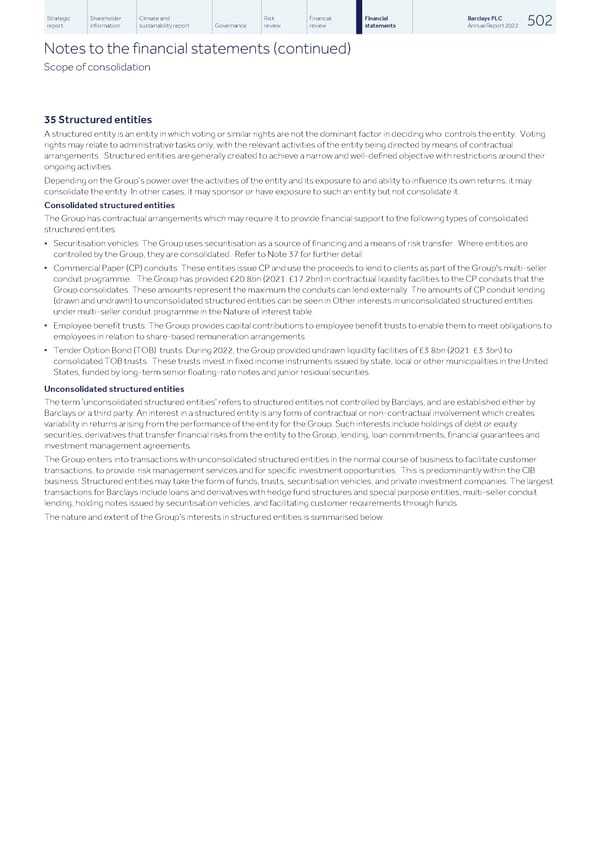Strategic Shareholder Climate and Risk Financial Financial Barclays PLC 502 report information sustainability report Governance review review statements Annual Report 2022 Notes to the financial statements (continued) Scope of consolidation 35 Structured entities A structured entity is an entity in which voting or similar rights are not the dominant factor in deciding who controls the entity. Voting rights may relate to administrative tasks only, with the relevant activities of the entity being directed by means of contractual arrangements. Structured entities are generally created to achieve a narrow and well-defined objective with restrictions around their ongoing activities. Depending on the Group’s power over the activities of the entity and its exposure to and ability to influence its own returns, it may consolidate the entity. In other cases, it may sponsor or have exposure to such an entity but not consolidate it. Consolidated structured entities The Group has contractual arrangements which may require it to provide financial support to the following types of consolidated structured entities: • Securitisation vehicles: The Group uses securitisation as a source of financing and a means of risk transfer. Where entities are controlled by the Group, they are consolidated. Refer to Note 37 for further detail. ▪ Commercial Paper (CP) conduits: These entities issue CP and use the proceeds to lend to clients as part of the Group's multi-seller conduit programme. The Group has provided £20.8bn (2021: £17.2bn) in contractual liquidity facilities to the CP conduits that the Group consolidates. These amounts represent the maximum the conduits can lend externally. The amounts of CP conduit lending (drawn and undrawn) to unconsolidated structured entities can be seen in Other interests in unconsolidated structured entities under multi-seller conduit programme in the Nature of interest table. ▪ Employee benefit trusts: The Group provides capital contributions to employee benefit trusts to enable them to meet obligations to employees in relation to share-based remuneration arrangements. ▪ Tender Option Bond (TOB) trusts: During 2022, the Group provided undrawn liquidity facilities of £3.8bn (2021: £3.3bn) to consolidated TOB trusts. These trusts invest in fixed income instruments issued by state, local or other municipalities in the United States, funded by long-term senior floating-rate notes and junior residual securities. Unconsolidated structured entities The term ‘unconsolidated structured entities’ refers to structured entities not controlled by Barclays, and are established either by Barclays or a third party. An interest in a structured entity is any form of contractual or non-contractual involvement which creates variability in returns arising from the performance of the entity for the Group. Such interests include holdings of debt or equity securities, derivatives that transfer financial risks from the entity to the Group, lending, loan commitments, financial guarantees and investment management agreements. The Group enters into transactions with unconsolidated structured entities in the normal course of business to facilitate customer transactions, to provide risk management services and for specific investment opportunities. This is predominantly within the CIB business. Structured entities may take the form of funds, trusts, securitisation vehicles, and private investment companies. The largest transactions for Barclays include loans and derivatives with hedge fund structures and special purpose entities, multi-seller conduit lending, holding notes issued by securitisation vehicles, and facilitating customer requirements through funds. The nature and extent of the Group’s interests in structured entities is summarised below:
 Barclays PLC - Annual Report - 2022 Page 503 Page 505
Barclays PLC - Annual Report - 2022 Page 503 Page 505